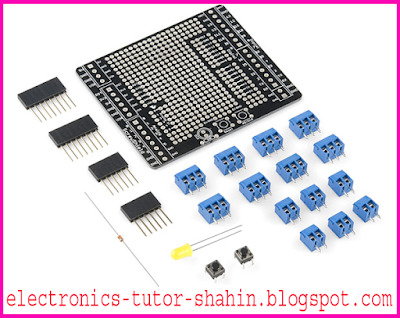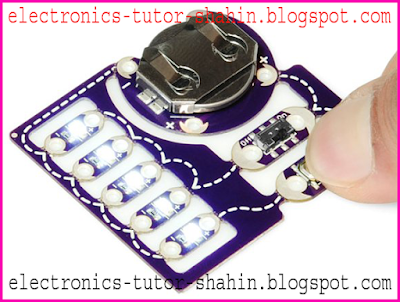Proto Screw Shield, Arduino in a bag in a frustratingly words that conjure up images of a prototype of drilling (I had to look it up), (who is not there?). That is not quite what we're going for, but you're imagining a versatile prototyping shield, that just about any electronic component, you're definitely on the right track with a CAN interface. Proto Screw Shield is always useful with screw terminal combines our proven Arduino ProtoShield.
In this guide, we hope to put together a fully-functional, Proto Screw Shield'll try to get. Assembly section, just a little something to push you in the direction of your next project will be followed by instructions to use.
 |
| ProtoScrewShield Kit Retail |
Proto Screw Shield assembling
You've probably noticed that the product looks nothing like the picture you've got pretty packaging. Before prototyping, screwing, and ... err ... talisman can begin, you need to assemble the Proto Screw Shield. Assembly is pretty straightforward, but it's easy to be through-hole soldering. If this is your first time picking up a soldering iron, I first would like to encourage you to attack one of our excellent tutorial on soldering. We are looking for someone to screw the shield is more like a piece of modern art, an enjoyable Arduino shield (yeah, that's only for the purpose of punishment is linked to The Simpsons clip) than do not want to end.
 |
| ProtoScrewShield Kit Retail |
At least, a couple of tools required for assembly of opposable, is really a basic soldering iron, solder a bit, and some are cutting. In addition to the equipment, and other items to help you keep everything nice and stable, needle nose pliers, and possibly a third hand, or can be included in the vise.
Before starting assembly, empty out your bag and make sure you've got all the parts should be:
- PCB screw 1x Shield
- 1x 5mm yellow LED
- 1x 330Ω resistor
- 2x 6-pin Stackable Headers
- 2x 8-pin Stackable Headers
- Momentary push button 2x
- 6x 2-pin 3.5mm screw terminals
- 8x 3-pin 3.5mm screw terminals
If any part is missing? (Bad SparkFun kitters!) Drop an email to our customer service team. We'll leave them to you as soon as possible.
Now, dig and find yourself familiar with the PCB screw Shield. If you're like me, you probably have to flip it back over and a couple of dozen times to figure out which side is the top. To avoid assembling the shield upside-down, remember that all parts of the outline with the top side of the PCB. It looks like this:
 |
| ProtoScrewShield Kit Retail |
 |
| MSPAINT skills beyond compare... |
If it was not obvious enough already, where each component of the plan will ultimately Proto Screw Shield itself as a good way to be exhibiting. I work from the lowest profile element, meaning starting with 330Ω resistor, buttons, LED (polarity must be careful!), And finally followed by paretabe header'd say. This method ensures that the material is generally flush with the PCB as possible, as are seated. You look pretty enough to take home to mother Proto Screw Shield, do not want?
A special note on the header, two in fact. Board labels are not nearly as clear as they should; You can insert just the header, where they go on the diagram to ensure that yesterday. Some places look like they can be inserted in the header, and if they do not go into these remote locations, will not be compatible with your shield Arduino-. Secondly, when you welded headers, as straight as possible to take care of them. I am the first of each solder pin, and then plug it into my Arduino all six or eight, the header pins are soldered to make sure everything lines up before, like.
Now, all that remains of the screw terminals. If you have not noticed how much the screw terminal rule, I invite you to take a closer look. Have you noticed how they slide together to form mega-screw-terminal? 2, 4, 6, and 8 varieties (of the three) of the formation of mega-screw-terminal combination of 2- and 3-pin screw terminal use. Necessary in order to complete all the mega-screw-terminal screw terminal there is enough, and should be filling your Proto Screw Shield. Screw terminals to ensure that the slide Take care of each other equally.
Mega-in screw-terminal complete with all of them in their respective PCB footprints in the insert. Verify that all of the input screw terminal is facing toward the outside of the PCB. Suppose you flip the board in each of the screw terminals and solder them into place as well. You may need an extra bit of solder to the pins. Proto Screw Shield looks something like the picture below you, then congratulations! If it is not, well, maybe you should invest in some solder wick; This is a bad time to learn how to solder!
 |
| ProtoScrewShield Kit Retail |
How to use Proto Screw Shield
Proto Screw Shield's prototyping area looks simple enough to use, but it may be dangerous for the health of your circuit if you plan to take part in it without soldering. Screw Shield is a lot of behind the scenes much more complicated than it looks and prototyping section. It is 5V and GND rails, grids and other pins trio, and full Arduino header extensions.
 |
| ProtoScrewShield Kit Retail |
I bet you were not expecting that much going on behind the scenes. The power and ground rails in a prototyping board can be most useful material. What is great about the two pairs of rails screw Shield power, and they're separated by four rows is unrelated prototyping holes. What is power crazy, surrounded by four rows of holes unrelated prototyping great about? Well, that's a 32-hole chips come in packages with pin DIP or less of the 0.3 "wide, dip chips means that their neighbors will sit perfectly within the power rails, and you can stick it to wire up an ATmega328 is a second Arduino. Op -AMPS, 555 timer, shift-register, motor driver, compatible chip list just goes on and on. this is a major bonus, because of the wire cloth sucks, and power lines kept as short as possible awesome!
Also adjacent to the crazy threesome is what I call a floating pink pins, pink away, they're at least in my diagram. These can be any number of use, but no one asked me to stick with servos are adjusting their charismatic. Server standard pinout for a negative energy, positive energy, signals, which left power rail and pink to match up well with the trio. A power rail and a triad unit in the male header pin solder a trio, a triad of a second pin solder pin PWM Arduino, and you've got an output for a server quickly.
Proto pins might look a bit tangled unusable, unless you have a hobby knife. Cutting a tradition that traces of PCB and PCB Design engineers who all had a moment of weakness and you've thrown a simulated wire trace back through the generations. A gridlocked prototyping area can really cut down on the cable, but you probably should not be to make sure that nothing is shorted to make trace the attack back to the board with a blade will be required.
The Proto Screw Shield, let's not forget the namesake share screw terminals. Many electronic components do not care that they're not compatible Arduino- (how inconsiderate). For example, in the electronics hobbyist has a special place in their heart for stranded wire, but the damn stuff all over the place just does not want to be inserted into the header of a woman without fraying. You do not want to deal with the durability of welded wire, screw terminal that is still a great alternative to a hard, physical connectivity is to leave you with. Screw terminal, motor, sensor, or LED can be a great way to interface with just a screwdriver, do not forget!
 |
| ProtoScrewShield Kit Retail |
Making use Proto Screw Shield
Proto Screw Shield is fully assembled, and the intricacies of using it with clear, responsible for some of you it is amazing. Make us proud! You tell us how you want to use your shield screw, drop us a line!
In this guide, we have a suggestion for how you can improve? No step aside? Unclear instructions? Please let us know. You can leave a comment below or email us spark@sparkfun.com. If the manual assembly of the most horrible experience you've ever let us know and we'll stop trying to improve.
















